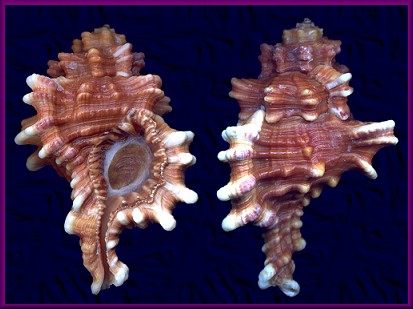|
Shells Are Where You Find Them - Lost Species Rediscovered |
|
By Bill Frank |
|
About a year and half ago, Mr. Russ Webb (Vice-President of the Oregon Shell Club) and his wife Sue, made a collecting trip to Fiji. During the trip while SCUBA diving at a depth of 45 feet, the Webbs collected a colorful 61 mm. specimen of Cymatium on the top of a coral reef drop-off (wall) in rubble. In the ensuing period, the identify of this specimen had proven elusive, so Mr. Webb wrote an article for the December issue of his club newsletter, accompanied by color photographs, soliciting identification assistance. The article was concurrently published in the Internet edition of Hawaiian Shell News. Your Editor, Assistant Editor (Harry G. Lee), and author* Betty Jean Piech of Wilmington, Delaware, immediately recognized the unidentified specimen as the very rare Cymatium (Ranularia) armatum (G. B. Sowerby III, 1897). According to Betty Jean, prior to Mr. Webb's recent find, only six specimens and a fragment were known to the scientific community. Both your Assistant Editor and Betty Jean, believe that this is probably the first live-collected specimen and the first specimen with reliable locality data. In congratulatory correspondence to Mr. Webb, Mrs. Piech recalled a story told to her by the late R. Tucker Abbott who reflected on a trip in the South Pacific and finding a shell that he really wanted. Dr. Abbott turned around to show it off to his fellow collectors - but on one was in shouting distance. So he said he just raised the shell in the air, looked up at the sky and shouted, "Look God, look what I just found!" Your C. armatum certainly warranted that type of reaction. Your Assistant Editor pointed out that it took exactly a century to document a living C. armatum after its first disclosure to science. *Piech, Betty Jean 1998. Ranellidae And Personidae: A Classification Of Recent Species, Delaware Museum of Natural History, Wilmington, DE. 60 pp. |
